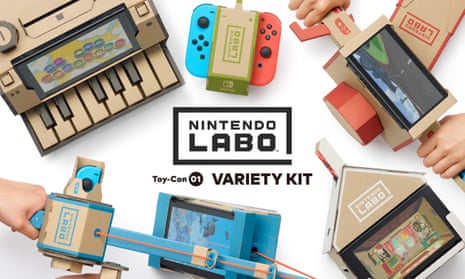Nintendo has introduced a new product for its Switch games console: Nintendo Labo, an innovative augmented-reality game that turns cardboard models into fully functioning toys.
Inside the Nintendo Labo box are 25 sheets of thick, brown, branded cardboard, and a little cartridge that pops into a Nintendo Switch console. Following Lego-like instructions on the Switch screen, you punch out the cardboard pieces and assemble them into contraptions of varying complexity. The first project, which takes maybe 15 minutes, is a simple little bug-like radio-controlled car; slot the Joy-Con controllers into its cardboard sides, pull up the controls on the Switch’s screen, and the vibrations send it juddering across a flat surface with surprising speed.
The more complex constructions are a telescopic fishing rod with a working reel, attached to a base with elastic bands and string for realistic tension; a cardboard model of a piano with springy keys; an abstract motorbike, with handles and a pedal; a little house. Each contraption is made out of cardboard and string, and transforms into a digitally augmented toy when you slot Joy-Con controllers and the Switch screen into it. The piano, especially, is quite amazing, and takes about two hours to build. The infrared camera on the Joy-Con controller can see reflective strips of tape on the back of the keys, which come into view when a key is pressed, telling the game software to play the right note. Cardboard dials and switches modify the tone and add effects to the sound.
The principles behind each construction – Toy-Cons, as Nintendo calls them – are explained by cartoon characters, putting a child-friendly spin on coding and engineering. On the Switch screen, you can view a cross-section of each model that illustrates what the Joy-Con camera can see and how it works. This educational element is geared towards curious children, but it’s also illuminating for an adult – seeing how these toys work only increases your appreciation of their ingenuity.
The most complex construction, which will be sold separately, is a cardboard mech suit that transforms your entire body into a Transformers-style robot in the game, translating your punches and kicks into building-levelling virtual smashes.

The finished Toy-Cons are surprisingly sturdy, but won’t stand up to extended enthusiastic play with younger kids. They do, however, dispense with the need to ever spend money on plastic accessories. Nintendo plans to offer replacement cardboard kits and templates for players who break theirs, but the easier solution is just to mend it. You can stick the cardboard Toy-Cons back together with glue or tape, reinforce them, or decorate them with pens, washi tape or googly eyes, without affecting their functionality. It’s easy to imagine creative players and the online maker community taking this customisation in unexpected directions.
Nintendo Labo addresses a limitation of existing augmented reality games that use camera technology to superimpose things on the real world: however much you might want to believe that you’re battling monsters, the reality that you’re pointing a phone at a card with a weird pattern on it dents the fantasy. Drawing on Nintendo’s history as a maker of toys, the Nintendo Labo creations are tangible physical objects, enhanced rather than conjured by the games console. It invites players to engage intellectually and creatively with the technology, and the careful process of building them makes for a more mindful toy than most digital entertainment, which will appeal to parents trying to moderate their kids’ screen time.
Nintendo of Europe’s president, Satoru Shibata, gave a statement: “Our goal is to put smiles on the faces of everyone Nintendo touches. Nintendo Labo invites anyone with a creative mind and a playful heart to make, play and discover in new ways with Nintendo Switch. I personally hope to see many people enjoying making kits with their family members, with big smiles on their faces.”
- Nintendo Labo will be released 27 April in Europe, 20 April in the US.

Comments (…)
Sign in or create your Guardian account to join the discussion